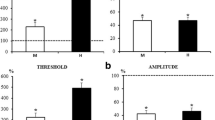Summary
-
1.
Reflexes involving hind leg muscles during movement of the coxo-trochanteral joint were recorded after total ipsilateral deafferentation except for one of two groups of mechanoreceptors. These were (i) HP and RH, and (ii) SR1, SR2 and MRO.
-
2.
Both groups of receptors influence coxotrochanteral and subcoxal, but not femoro-tibial muscles (Figs. 2, 3; Table 1).
-
3.
Many subcoxal muscles are activated by both antagonistic groups of receptors. Their co-contraction may lock the subcoxal joint in a rigid position, thereby making it a firm support for resistance reflexes in more distal joints.
-
4.
Reflexes onto coxo-trochanteral muscles were studied in more detail by direct selective mechanical stimulation of single receptors. All receptors elicit typical resistance reflexes: Sense organs sensitive to joint depression (SR1, SR2, MRO) activate levator motor units and inhibit depressor activity (Fig. 4). Sense organs sensitive to levation (HP, RH) cause analogous reactions of opposite sign (Fig. 5).
-
5.
Tonic excitation by proprioceptors is necessary to maintain a certain level of spontaneous activity in certain motor neurons. For example after HP and RH extirpation, spontaneous activity of depressor motor units ceases, MRO ablation has comparable effects on levator units (Table 1).
Similar content being viewed by others
Abbreviations
- CNS :
-
central nervous system
- HP :
-
hairplate
- MRO :
-
muscle receptor organ
- RH :
-
row of hairs
- SR :
-
strand receptor
References
BrÄunig P (1983) Morphologie und Physiologie rumpfnaher Propriorezeptoren des Heuschrecken-Sprungbeins und ihr Einflu\ auf dessen motorisches System. Dissertation, UniversitÄt Konstanz
BrÄunig P, Hustert R (1985) Actions and interactions of proprioceptors of the locust hind leg coxo-trochanteral joint. I. Afferent responses in relation to joint position and movement. J Comp Physiol A 157:73–82
Burns MD (1973) The control of walking in Orthoptera. I. Leg movements in normal walking. J Exp Biol 58:45–58
Burrows M, Hoyle G (1973) Neural mechanisms underlying behavior in the locustSchistocerca gregaria. III. Topography of limb motorneurons in the metathoracic ganglion. J Neurobiol 4:167–186
Campbell JI (1961) The anatomy of the nervous system of the mesothorax ofLocusta migratoria migratorioides (R. & F.). Proc R Zool Soc Lond 137:403–432
Field LH, Rind FC (1981) A single insect chordotonal organ mediates inter- and intra-segmental leg reflexes. Comp Biochem Physiol A 68:99–102
Hustert R (1983) Proprioceptor responses and convergence of proprioceptive influence on motoneurones in the mesothoracic thoraco-coxal joint of locusts. J Comp Physiol 150:77–86
Hustert R, Pflüger HJ, BrÄunig P (1981) Distribution and specific central projections of mechanoreceptors in the thorax and proximal leg joints of locusts. III. The external mechanoreceptors: The campaniform sensilla. Cell Tissue Res 216:97–111
Lissmann HW (1950) Proprioceptors. Symp Soc Exp Biol 4:34–59
Pringle JWS (1961) Proprioception in arthropods. In: Ramsay JA, Wigglesworth VB (eds) The cell and the organism. Cambridge University Press, Cambridge, pp 256–282
Snodgrass RE (1929) The thoracic mechanism of a grasshopper and its antecedents. Smithson Misc Collect 82:1–111
Spinola SM, Chapman KM (1975) Proprioceptive indentation of the campaniform sensilla of cockroach legs. J Comp Physiol 96:257–272
Wendler G (1971) Körperhaltung bei der StabheuschreckeCarausius morosus: ihre Beziehung zur Schwereorientierung und Mechanismen ihrer Regelung. Verh Dtsch Zool Ges 65:214–219
Wilson DM (1962) Bifunctional muscles in the thorax of grasshoppers. J Exp Biol 39:669–677
Zill SN, Moran, DT (1981) The exoskeleton and insect proprioception. I. Responses of tibial campaniform sensilla to external and muscle-generated forces in the American cockroach,Periplaneta americana. J Exp Biol 91:1–24
Author information
Authors and Affiliations
Rights and permissions
About this article
Cite this article
BrÄunig, P., Hustert, R. Actions and interactions of proprioceptors of the locust hind leg coxo-trochanteral joint. J. Comp. Physiol. 157, 83–89 (1985). https://doi.org/10.1007/BF00611098
Accepted:
Issue Date:
DOI: https://doi.org/10.1007/BF00611098




